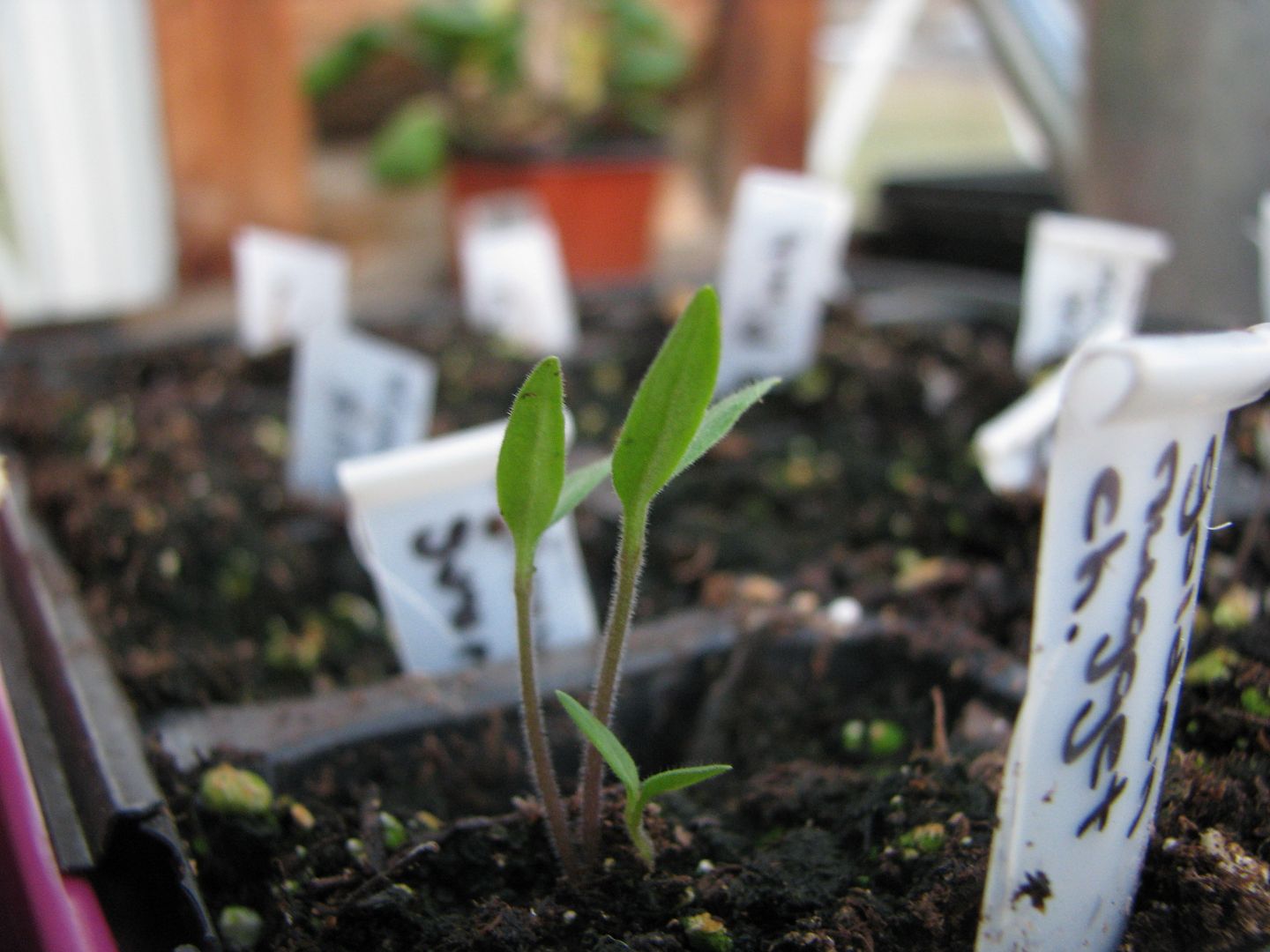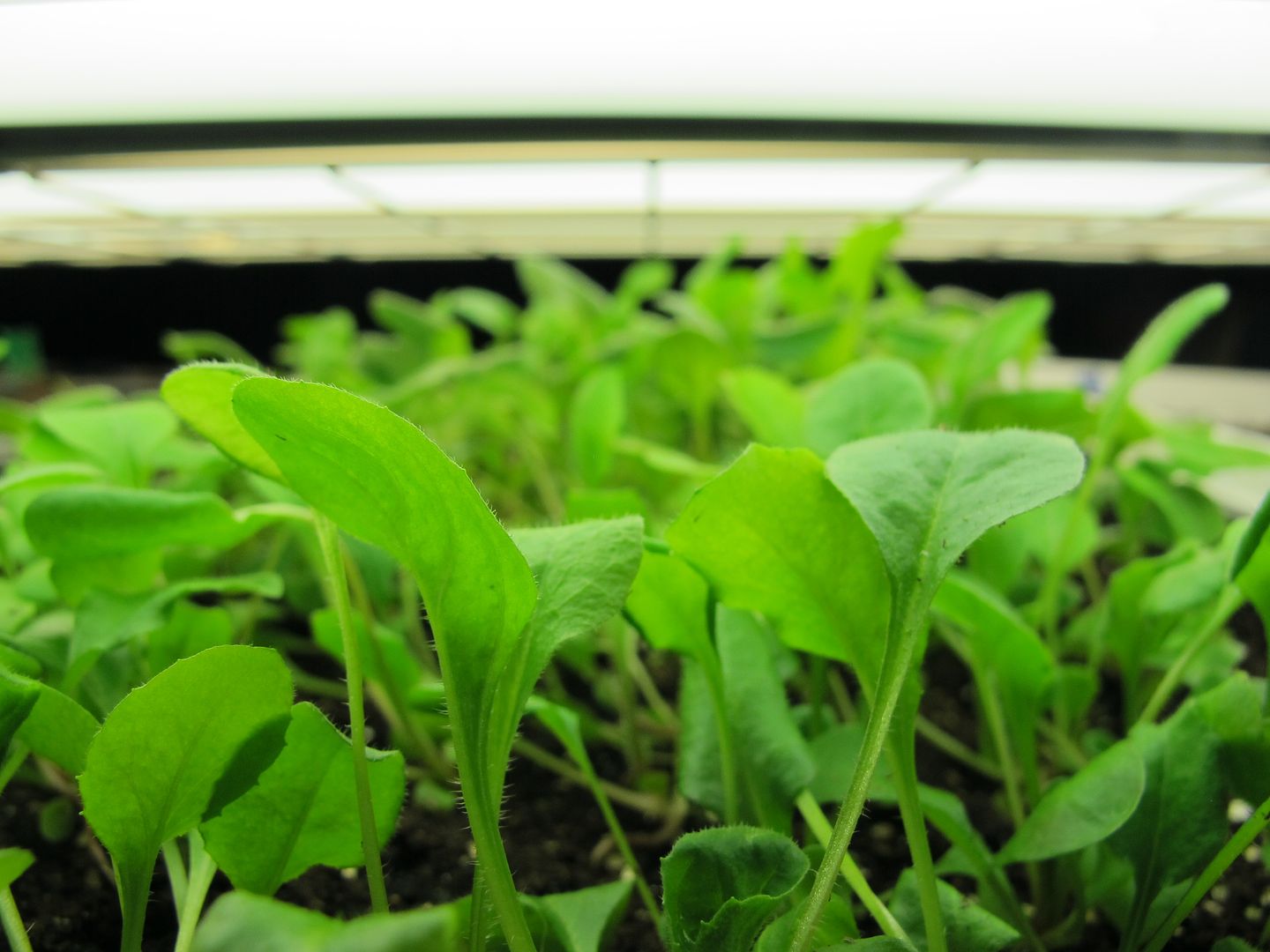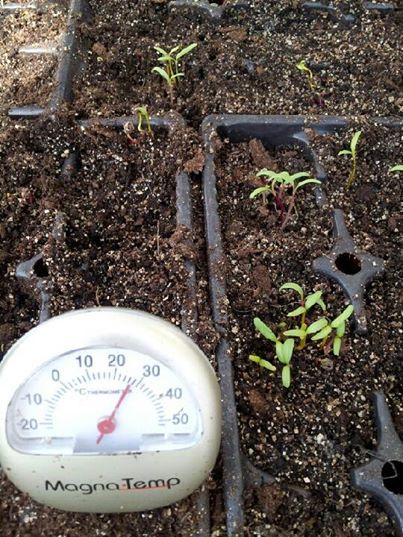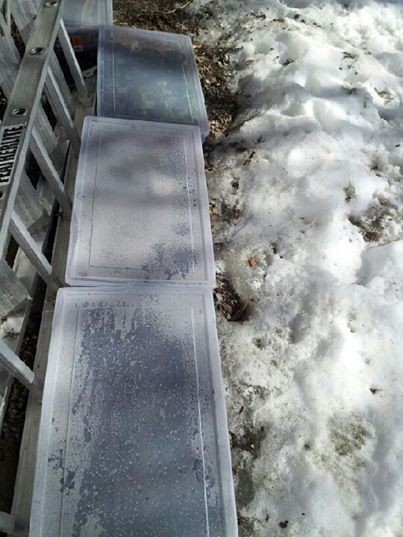
2012 tomato seedlings hanging out in a small greenhouse. That was a warm year.
Now that you are diligently starting seeds, you may have googled last frost date and found that it is in the first week of May! Before you start counting back six weeks, remember this is the AVERAGE last frost date. This means that when all the last frost dates for last fifty years including those that occurred in April and those that occurred in June were averaged out, it gave May 6th as the middle point. This does not mean that we can rely on it as the day after which we can plant out tomatoes. To do that, we have to do a little speculating.
At the beginning of May, the risk for frost is still relatively high but as May fades into June, it drops off quickly to very little chance. Therefore every week waited, is less risky. This might be balanced off of other needs such as growing season, absences from the garden, ability to protect plants under plastic or a winter blanket or a particular microclimate.
But wait, water freezes at 0C like we were taught at school right? Well, yes, the freezing point of water is 0C however there are a couple complicating factors. Firstly, water is actually at its most dense at 4C. The molecules are then closest together and cannot easily move past each other. They start to arrange themselves into what will be their solid crystalline structure: ice. Unlike most solids, water expands as it freezes. One of the interesting consequences of this is that ice forms and floats on the surface of a pond. Imagine if it didn't!
Secondly, just because the thermometer said 4C on your house, does not mean that little hollow in the yard was not at or below 0C since cold air sinks. Air circulation, humidity and cloud cover all play a part. For example, wind can keep air moving around and prevent it from settling and open skies mean that ground heat may be lost. Also some materials, like metal, cool more quickly meaning you might have frost on your car but not on the ground.
Even a few frost tender plants can be planted out a few weeks early (if you want to risk it), including potatoes. As these are under heavy piles of insulating mulch/dirt, their foliage usually takes a while before it is exposed to the air above so you can put out a few weeks before you are absolutely sure there will be no more frost.

Litchi tomato or vila-vila, a nightshade with yummy fruit and ouchy spines. It will withstand light frosts when mature (not tried with seedlings)
Last frost is not 0C
But wait, water freezes at 0C like we were taught at school right? Well, yes, the freezing point of water is 0C however there are a couple complicating factors. Firstly, water is actually at its most dense at 4C. The molecules are then closest together and cannot easily move past each other. They start to arrange themselves into what will be their solid crystalline structure: ice. Unlike most solids, water expands as it freezes. One of the interesting consequences of this is that ice forms and floats on the surface of a pond. Imagine if it didn't!
Secondly, just because the thermometer said 4C on your house, does not mean that little hollow in the yard was not at or below 0C since cold air sinks. Air circulation, humidity and cloud cover all play a part. For example, wind can keep air moving around and prevent it from settling and open skies mean that ground heat may be lost. Also some materials, like metal, cool more quickly meaning you might have frost on your car but not on the ground.
I plant before last frost

Bellis perennis - English Daisy - growing under lights for spring flowers and greens.

Bellis perennis - English Daisy - growing under lights for spring flowers and greens.
But not tomatoes. I plant all sorts of greens, roots and peas even though there is the possibility of last frost. Plants' frost tolerance vary (sometimes even within a particular plant's life cycle) so that though peas can be planted even though there may be dusting of snow in the future - assuming the soil is workable - beans will rot in the ground or die if they sprout. Peas and parsnips are amoung the most frost hardy seedlings I know. Others will take a little cold such as lettuce and carrots though not a heavy frost. And still others are fair weather plants and must only be planted out after chance of frost such as tomatoes and cucumbers.
What this means is that when a seed package says start 4-6 weeks before planting out, they may not be referring to after last frost. Violas, for example, can be planted out when the temperature are still cool. As they need quite a big headstart, you'll be starting those in early winter and planting out in mid-spring!
Knowing what to plant when will keep it from being a one-stop weekend of planting fury in late May as well as extending your season. Another planting of frost hardy greens, for example, can be sowed to mature after first frost in autumn.
Of course, there is frost and there is frost. A light frost above -2C is different from a heavy frost below -4 where the ground freezes and different again if it is a one night thing or continuing for weeks.
What this means is that when a seed package says start 4-6 weeks before planting out, they may not be referring to after last frost. Violas, for example, can be planted out when the temperature are still cool. As they need quite a big headstart, you'll be starting those in early winter and planting out in mid-spring!
Knowing what to plant when will keep it from being a one-stop weekend of planting fury in late May as well as extending your season. Another planting of frost hardy greens, for example, can be sowed to mature after first frost in autumn.
Of course, there is frost and there is frost. A light frost above -2C is different from a heavy frost below -4 where the ground freezes and different again if it is a one night thing or continuing for weeks.
Frost as a helper
Many seeds have built in dormancy mechanisms that keep them from germinating until conditions are right for maximum success. This is quite common with wildflowers and trees that have evolved in temperate areas such as around Ottawa. Needing a period of cold before popping roots means they'll germinate in the spring. Some even require oscillating temperatures. If you have some wildflower seeds that you haven't stratified (in the fridge or seeded in the garden in the fall or by wintersowing), then you can try putting them out very early in the spring. The soil will be moist and cold temperatures are probably still in the forecast. You may also have time to moist stratify in the fridge using the baggie method.
Sometimes, plants are started very, very early in order to get them out when it is cold so that you trick them into thinking they have already gone through one complete growing season including winter. This is done to get certain plants to flower the first year when they would normally wait until the second such as globe artichoke or sweet william.
Sometimes, plants are started very, very early in order to get them out when it is cold so that you trick them into thinking they have already gone through one complete growing season including winter. This is done to get certain plants to flower the first year when they would normally wait until the second such as globe artichoke or sweet william.
Even a few frost tender plants can be planted out a few weeks early (if you want to risk it), including potatoes. As these are under heavy piles of insulating mulch/dirt, their foliage usually takes a while before it is exposed to the air above so you can put out a few weeks before you are absolutely sure there will be no more frost.
Thwarting last frost: plasticulture

Inside the grow-boxes above are some seeds and seedlings. Here are some crowded swiss chard in need of a little thinning. Look at the temperature inside. Outside it was about -2C but sunny.

Inside the grow-boxes above are some seeds and seedlings. Here are some crowded swiss chard in need of a little thinning. Look at the temperature inside. Outside it was about -2C but sunny.
Some people plan on putting out their vegetables under season extension devices such as walls-o-water, cold frames, polytunnels, cloches or beneath floating row covers. These can all help moderate the temperature though they are not fail-safe. I like to use these for plants that are frost tolerant. They won't be killed if temperatures do drop but they may grow faster and experience less stress with their blankies overtop.
If you did plant your tomatoes and think that a frost blanket will not be enough AND you don't have a pile of plants, you can dig them up and replant again later. It's not the best solution but it will save your plants.
If you did plant your tomatoes and think that a frost blanket will not be enough AND you don't have a pile of plants, you can dig them up and replant again later. It's not the best solution but it will save your plants.
When is last frost REALLY?

Litchi tomato or vila-vila, a nightshade with yummy fruit and ouchy spines. It will withstand light frosts when mature (not tried with seedlings)
It varies from year to year. That is the joy of gardening. We are working with nature who is not always so predictable. Generally it is safe to put out tender starts somewhere around the end of May though occasionally I've had to wait until the first week of June. So when calculating when to start seeds, count six weeks back from mid-late May rather than early May. However, if you've given your tomatoes a couple extra weeks head start, it's not a problem. As long as they are in big enough pots, they can wait until the weather warms. If you have really big tomato babies, plant a portion of the stem under ground as they will root along the stem. This is a trick for a sturdy plant.
I wait to plant out tomatoes around the third week of May and then look at the longterm forecast. The risk of frost drops precipitously as we approach June. If it looks fair, then I'll plant but with the proviso that I might have to cover if the weather takes a sudden turn. Also weather trends can help you determine if it will be a late or early year. Looking at the long-longterm forecast for spring 2014 suggests lower than average temperatures. Stormy, cold weather has been the norm since last fall and it doesn't seem to be letting up. I would probably not even contemplate planting out until near the end of May unless we get a sudden reversal of fortune.
What kind of planter are you?
1. May is spring:
* Lives in a sheltered place
* Has lots of seeds or plants of frost tender varieties
* Doesn't really care if everything needs replanting
* Gardens in pots that can be moved inside
Will plant at the beginning of May.
Risk Taker
Risk Taker
2. Middle May:
* Plants when it's getting warm
* Lives in the city or a sheltered location, not a frost pocket
* Has to go away on a trip at the end of May (my usual reason)
* Will happily cover if there is frost
Plants when the weather is fine
Optimist
Optimist
3. Late May:
* May 2-4 weekend is when you plant tomatoes!
* I have to plant. My seedlings are crawling out of their pots!
It's worked for generations!
Traditionalist
Traditionalist
4. Beginning of June:
* There is always a late frost (not so)
* These are my precious babies and I'm not risking them.
* Too much work to cover
* I just bought these seedlings. That's okay right?
Plants when danger of frost is a distant memory
Nervous Nelly or Nettle if you prefer
Nervous Nelly or Nettle if you prefer
Mid June:
* Oops, I have to plant a garden?
Procrastinator
Procrastinator
Right, okay, so just tell me when to plant them!
As I said, gardening, like nature, is a wonder of patterns and variation. If I were to advise someone, I'd say around the long May weekend but that every year is different. Many, many times I've planted out in mid-May with excellent results especially in the city. In the country, I try to wait until around the end of the month as I have a lot more plants than I want to bother to cover. I have seen last frost as early as the end of April and as late as the first week of June. If I had to pin a number on it, I'd say around May 20 but if I had to guess for this year, I'm going with May 31st.
Lastly, the proper wording on seed packets for planting out should be 'after all danger of frost' rather than after last frost.
Lastly, the proper wording on seed packets for planting out should be 'after all danger of frost' rather than after last frost.


With over 40 years of gardening experience in rural Ottawa, I've followed the moon calendar for planting out frost-tender plants. It's amazing how close last frost, for the rural Ottawa Valley, happens on the first full moon of June when the full moon falls in the first two weeks of June. And many plants sulk in cold, water-laden clay soils. Keeping warm soil-loving plants in their pots, as if 'hardening-off' (i.e. bring them into warmth when temperatures look like they'll hit +2C) gives plants a 'leg up' on those exposed to chilly nights and cold-prone soils.
ReplyDeleteAnother variable for sure! Sandy versus clay soil makes a big difference for soil warmth as does topography, raised beds, radiating wall heat etc… It's such a wonderfully multifaceted thing gardening. I have sandy soil so as soon as the water table drops, the soil is workable. However, I have friends in the city that plant peas later because their soil is more clay based so it is much colder. Soil warmth is another excellent discussion piece!
ReplyDeleteI'm totally a traditionalist. Mainly because I was taught that way, but also because the last weekend in May is usually a long weekend, so I get an extra day to plant before the work week begins again. :)
ReplyDeleteHello!
ReplyDeleteFollowed a trail here from a 2011 post you made elsewhere about perennial kale -- and was wondering if you could provide an update / more information?
I have a couple of plants of red russian variety kale from my locally saved seed that seem to have come through a second winter (as in, their second -- flowering -- year was last year, and I never bothered to pull them), and are now sending out new growth.
Any experience with this?
Thanks! :D
Hello!
ReplyDeleteFollowed a trail here from a 2011 post you made elsewhere about perennial kale -- and was wondering if you could provide an update / more information?
I have a couple of plants of red russian variety kale from my locally saved seed that seem to have come through a second winter (as in, their second -- flowering -- year was last year, and I never bothered to pull them), and are now sending out new growth.
Any experience with this?
Thanks! :D
(Posting again because I'm not sure if my first made it past the verification string. Apologies if it's a double.)
WayStone: Red Russian seems to be fairly hardy and often a 'short' lived perennial. I had Daubenton overwinter for two almost three winters (something else killed it off after the winter of 2011/12). I now have seedlings of Daubenton and crosses (they flower rarely but I was able to get ahold of true seed from some rare flowering events) so am hoping to trail them. Where are you located?
ReplyDeleteWayStone: I tried to follow your link but your profile is not public. I'd like to communicate with you about a possible collaboration if you are interested.
ReplyDeleteThanks for the reply! I don't use Blogger much, so I must have left it locked down.
ReplyDeleteDrop me a message at https://www.facebook.com/waystone, and we can certainly talk -- I'd love to nurture this kale trait too, if I can.
Oh -- and, Zone 5, southern NH. http://myfolia.com/gardener/Waystone for more info on my garden and environs.
ReplyDelete